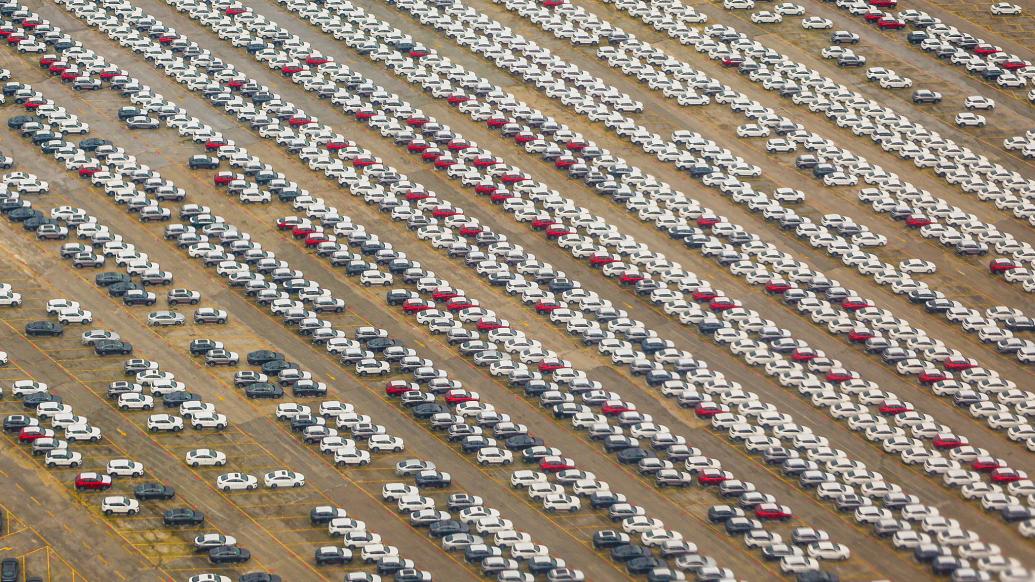Economic Daily: Refuting the "China's new energy overcapacity theory"
- 27 August, 2024
The BMW Group recently announced that it will invest an additional 20 billion yuan in its Shenyang production base in order to achieve localized production of BMW's "new generation" models in 2026. The judgment, decision-making and investment "voting" of multinational companies reflect the good expectations for China's new energy vehicle market and effectively refute the "China's new energy overcapacity theory" concocted by some people in the United States.

On May 4, 2024, Chongqing City, a high-altitude bird's-eye view of the finished new car parking lot in the domestic new energy vehicle production park.
Recently, some politicians and media in the United States have joined forces to hype the so-called "China's new energy overcapacity theory" in an attempt to provide an excuse to implement more economic and trade restrictive measures against China. These bizarre arguments and unreasonable attacks against China's new energy automobile industry have nothing more than three points:
First, China's new energy vehicle production capacity far exceeds demand and has become "an unbearable burden on the world." This argument claims that China’s current overcapacity in new energy is putting pressure on industrial development, corporate survival and people’s employment in various countries.
Overcapacity usually refers to an industry's actual production capacity being too high relative to market demand, resulting in oversupply. Specific to the new energy vehicle industry, this means that consumption growth is weak, industry capacity utilization is low, and companies have to suspend production. But the actual situation is that China's new energy vehicles show strong market demand and strong growth momentum. Data from the China Association of Automobile Manufacturers shows that in the first quarter of this year, China's new energy vehicle production and sales reached 2.115 million and 2.09 million respectively, a year-on-year increase of 28.2% and 31.8% respectively. The market share reached 31.1%, and the market scale continued to expand.
The just-concluded Beijing International Auto Show was extremely popular, and new energy vehicles are highly favored. Many multinational car company executives also felt the audience's enthusiasm for new energy vehicles at the scene, and they all said that they would "accelerate the launch of electrified products" and keep up with "China's speed." Those who spread the theory of "China's new energy overcapacity" turn a blind eye to this.
The automobile is a highly globalized industry and the main force that determines a country's industrialization process, supports the energy revolution, and absorbs the latest technologies of the era. At present, the world's third energy revolution and fourth industrial revolution resonate, and new energy vehicles have become a promising strategic emerging industry. In the context of economic globalization, judging whether there is excess production capacity in related fields must not only look at domestic market demand and industrial operation conditions, but also global market demand, industry development trends and potential.
From the perspective of the global market, the current production capacity of new energy vehicles is far from meeting market demand, especially in many developing countries, which have huge potential demand for new energy vehicles. Last year, global sales of new energy vehicles were 14.65 million, a year-on-year increase of 35.4%. The average market penetration rate in major countries was only 16%. According to estimates by the International Energy Agency, global demand for new energy vehicles will reach 45 million units in 2030, more than three times that of 2023. This means that global demand for new energy vehicles will continue to grow strongly in the next 10 years.
From the perspective of industrial development trends and potential, China's new energy automobile industry is also worth looking forward to. The current shift from oil to electricity in China's automobile market has crossed the dividing line. According to data from the National Passenger Car Association, in the first half of April this year, the retail penetration rate of new energy passenger vehicles in China was 50.39%, surpassing traditional fuel passenger vehicles for the first time. This shows that new energy vehicles have become the mainstream of the market. The cumulative effect of trends will, over time, open up greater market space for the development of new energy vehicles in the future.
Second, it is claimed that the development of new energy vehicles in China is highly dependent on government subsidies, leading to "unfair competition." This argument admits that China's new energy vehicle industry already has global competitive advantages, but the advantage is formed by relying on "huge state subsidies". It says that "no country in the world subsidizes its priority industries as heavily as China", thus throwing out the " "distorting global markets".
The vigorous development of China's new energy industry relies on the continuous independent innovation of enterprises, a more stable and secure supply chain, a higher degree of industrial agglomeration, fuller market competition, and the strong support provided by the ultra-large-scale market for rapid iteration of technology. These factors have jointly enabled China's new energy vehicles to achieve breakthroughs and lead the world in terms of production and sales scale, technological innovation, and industrial chain cultivation, forming a strong competitive advantage. Instead, the United States introduced the "Inflation Reduction Act" in 2022, announcing that it would provide up to $369 billion to provide tax incentives and subsidies for clean energy industries, including new energy vehicles in the United States, and intentionally exclude countries such as China. Such "double standards" are truly unfair to China's new energy vehicle industry.
Third, it slanders that China’s domestic market for new energy vehicles is insufficient in consumption and has to be “dumped overseas at low prices.” This argument claims that China's new energy vehicles are being dumped overseas at low prices, labeling China's high-quality production capacity that benefits the world as "hurting other countries' industries" and "impacting the world economy."
The fact is that China's new energy vehicles are not only not dumped at low prices, but also sell for much more in overseas markets than at home. Take the BYD Dolphin as an example. Its domestic price starts at 116,800 yuan, while its price in Germany starts at 35,990 euros (equivalent to about 270,000 yuan). The latter is more than twice the former. As a profitable company, BYD's production costs must be lower than overseas sales prices. This in turn proves that the so-called "low-price dumping" argument by some people in the United States is simply untenable.
The British "Sunday Times" published an article saying that "China is not 'dumping' at a price lower than its own selling price or at a loss", and said that "it is absurd to exclude the cheapest electric cars." Relying on the advantages of electrification and intelligence, China has provided the global market with new energy vehicles of high quality and low prices, allowing people in more countries to enjoy the convenience and benefits brought by cost-effective products, and improving the welfare of all mankind. China's new energy industry provides the world with high-quality and scarce production capacity, and there is broad room for future market development.
In the face of global warming, the New York Times website reported that "among all changes in the global effort to delay further climate warming, electric vehicle sales are the only category that is consistent with achieving climate goals." It is not difficult to see that when talking about combating climate change, some people in the United States believe that new energy production capacity is still insufficient; when talking about China's new energy industry, they blame "overcapacity." Some people in the United States are asking consumers to switch to electric vehicles, but they are also trying to prevent China's more affordable electric vehicles from being supplied to the world. Behind such contradictions is obviously not China's "overcapacity" but the "overanxiety" of some people in the United States.
It is understandable to be anxious about China's new energy industry outperforming one's own. However, the way to alleviate anxiety is not to hinder or hold back competitors who are running ahead and create unfair competition. Instead, one should focus on improving one's own In terms of "speed" and "stamina", he can catch up or even surpass them based on his strength. In fact, in the context of economic globalization, it is difficult to allocate manufacturing resources in one country. Producing a new energy vehicle often requires the cooperation and coordination of multiple countries and enterprises. Some people in the United States are trying every means to suppress China's new energy vehicles. In fact, they are also undermining the stability of the global industrial chain and harming the interests of other countries in the industrial chain.
From the so-called "China threat theory" to the "China shock theory" to the "overcapacity theory", variants of the "China threat narrative" are constantly being constructed. In fact, they are making excuses for some people in the United States to undermine fair market principles and justify a protectionist economy. Policy seeks justification. But this time the performance was like racing on a cliff at high speed, no matter how superb the driving skills were, the risk of overturning could not be avoided.










0 Comments